Kelan Phil Cohran was a jazz musician. He was best known for playing trumpet in the Sun Ra Arkestra in Chicago from 1959 to 1961, and for his involvement in the foundation of the Association for the Advancement of Creative Musicians (AACM).

The Magic City is an album by the American jazz musician Sun Ra and his Solar Arkestra. Recorded in two sessions in 1965, the record was released on Ra's own Saturn label in 1966. The record was reissued by Impulse! in 1973, and on compact disc by Evidence in 1993.
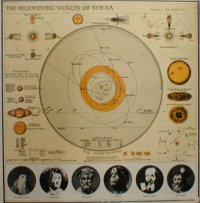
The Heliocentric Worlds of Sun Ra, Volume Two is a 1965 recording by the jazz musician Sun Ra and his Solar Arkestra. Where Volume One of the Heliocentric Worlds series had predominantly featured short abstract pieces, Volume Two features longer pieces performed by a smaller group, making it closer in spirit to the contemporaneous The Magic City, released on Ra's own Saturn label. The record has been widely bootlegged, some versions of which were retitled The Sun Myth.

Angels and Demons at Play is a jazz album by Sun Ra and his Myth Science Arkestra.

Sound of Joy is an album by Sun Ra and his Arkestra. It features the Arkestral lineup during the last few months of 1956, after trombonist Julian Priester left to join Lionel Hampton, Charles Davis became a regular member of the band, and Victor Sproles took over on bass. It was intended as the follow-up to Jazz By Sun Ra but Transition Records ceased to operate before it could be released.
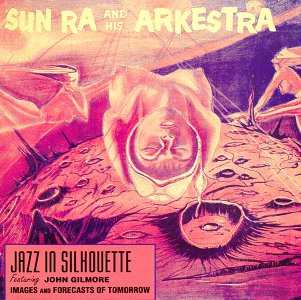
Jazz in Silhouette is a jazz album by pianist-composer Sun Ra and His Arkestra. It was recorded on March 6, 1959 and released in May of the same year. The album was recorded in Chicago during a session that also included the whole of the albums Sound Sun Pleasure!! and "Interstellar Low Ways" from the album of the same name.

Super-Sonic Jazz is an album by Sun Ra, recorded in 1956 at RCA Studios, Chicago. Super-Sonic Jazz was the first album to be released on Saturn Records, the label run by Sun Ra and Alton Abraham, and was one of only three albums by Sun Ra to have been available in the 1950s.

Sound Sun Pleasure!! is an album by the American Jazz musician Sun Ra and his Astro Infinity Arkestra. Recorded March 6, 1959, it remained unreleased until 1970 when it was issued on the Saturn label. Recorded at the same time and with the same personnel as Jazz in Silhouette, the album is unusual amongst early Ra albums for predominantly featuring jazz standards.

Sun Ra and his Solar Arkestra Visits Planet Earth is a jazz album by the American musician Sun Ra and his Solar Arkestra. Recorded between late 1956 and 1958, the album was originally released on Ra's own Saturn label in 1966, and was reissued on CD by Evidence in 1992. In keeping with many Saturn releases, one side features cuts from the arkestra c.1958, whilst the other side comes from the 1956 sessions originally intended for Sound of Joy but still unreleased in 1966.
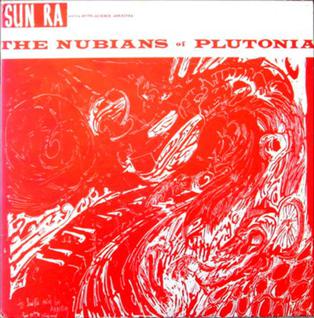
The Nubians of Plutonia is an album recorded by Sun Ra and his Myth Science Arkestra c.1958 - 1959 and released c.1966 on his own Saturn label. Originally released in a blank sleeve under the title The Lady With The Golden Stockings, the album had gained its current title, and sleeve by Richard Pedreguera, by 1969. In common with most releases by Sun Ra at the time, the record was printed in extremely limited numbers and primarily available at concerts and mail-order. The record was reissued by Impulse! in 1974, and on CD by Evidence in 1993, backed with the contemporaneous album Angels and Demons at Play.
"The Nubians of Plutonia... evidence an Arkestra moving into ever looser, more abstract ground. The percussion becomes more varied and moves ever closer to the foreground. 'The Golden Lady' seduces with a swaying groove created by a combination of simple parts: hi-hat, cow bell, wood blocks, rolling floor toms and bass. Ra then sets up a dark melodic theme, and then the Arkestra proceeds to weave a series of jaunty, blues-tinged solos into the fabric of the groove. 'Nubia', 'Africa' and 'Aiethopia' continue this excursion into more mystical, rhythm-based territory. The Arkestra utilizes the same ominous, simmering percussion beds, now augmented by more exotic instruments like Pat Patrick's 'space lute', which gives a playfully sinister sound to 'Africa'.... This powerful, multi-faceted music is a great place to start if you are just beginning to travel with Sun Ra, or a great way to continue the journey." Mathew Wuethrich

Interstellar Low Ways is an album recorded by the American jazz musician Sun Ra and his Myth Science Arkestra, mostly recorded in Chicago, 1960, and released in 1967 on his own El Saturn label. Originally titled Rocket Number Nine, the album had acquired its present name, and the red-on-white sleeve by Claude Dangerfield, by 1969. The album is known particularly for the two songs featuring chants, "Interplanetary Music" and "Rocket Number Nine Take off for the Planet Venus". These would stay in the Arkestra's repertoire for many years:
Rocket Number Nine points toward the music that the Arkestra would be playing on the lower East Side of New York City. The tenor sax solo isn't the work of John Coltrane in 1962, but of John Gilmore in 1960. And not even Ornette Coleman's bassists were playing like Ronnie Boykins at this date.
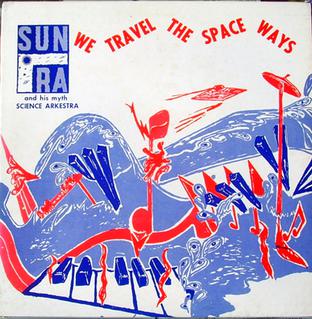
We Travel the Space Ways is an album by the American jazz musician Sun Ra and his Myth Science Arkestra. Recorded mostly in 1960, the album was released in 1967, on Sun Ra's own label Saturn. The album brings together a number of eras and personnel of the Arkestra, and was probably mostly recorded by Ra himself during rehearsals.
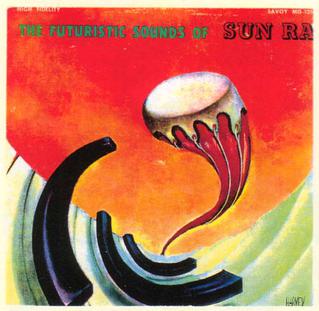
The Futuristic Sounds of Sun Ra is an album by the American jazz musician Sun Ra and his Arkestra, recorded on October 10, 1961, for the Savoy label and released in 1962.

Bad and Beautiful is an album by the American jazz musician Sun Ra and his Arkestra. Recorded in 1961 in New York City at the Choreographers' Workshop, 414 W. 51st St., the album was the second to be recorded in New York by the Arkestra after leaving Chicago, but would remain unreleased until 1972. The album is considered to represent an important transition between the big band approach of the Chicago recordings, and the more 'outside' approach of Ra's smaller bands recorded later in the decade:
'Aside from "Exotic Two," the tunes are split between standards and blues originals, but there are indications of the direction the Arkestra would take throughout the '60s. "Search Light Blues" has some interesting percussion accents finding their way into the arrangement, and "Exotic Two" alludes more clearly to the percussion-heavy sound that dominated many of the '60s recordings. Sun Ra plays piano exclusively on this recording, and Gilmore gets lots of room to shine. A significant transitional LP, this is probably the last "inside" record the Arkestra would record as they forged new sonic paths into the mid-'60s.' Sean Westergaard, All Music Guide link

Art Forms of Dimensions Tomorrow is an album by the American jazz musician Sun Ra and his Solar Arkestra. Often considered the first of Ra's 'outside' recordings, the album was the first to make extensive use of a discovery by the Arkestra's drummer and engineer Tommy Hunter:
'Art Forms of Dimensions Tomorrow.... contained "Cluster of Galaxies" and "Solar Drums", two rhythm section exercises with the sound treated with such strange reverberations that they threatened to obliterate the instruments' identity and turn the music into low-budget musique concrète. While testing the tape recorder when the musicians were tuning up one day, Hunter had discovered that if he recorded with the earphones on, he could run a cable from the output jack back into the input on the recorder and produce massive reverberation:
"I wasn't sure what Sun Ra would think of it... I thought he might be mad - but he loved it. It blew his mind! By working the volume of the output on the playback I could control the effect, make it fast or slow, drop it out, or whatever." [Tommy Hunter]
'By the 1950s commercial recording companies had developed a classical style of recording which assured that the recording process itself would be invisible... but Sun Ra began to regularly violate this convention on the Saturn releases by recording live at strange sites, by using feedback, distortion, high delay or reverb, unusual microphone placement, abrupt fades or edits, and any number of other effects or noises which called attention to the recording process. On some recordings you could hear a phone ringing, or someone walking near the microphone. It was a rough style of production, an antistyle, a self-reflexive approach which anticipates both free jazz recording conventions and punk production to come.' John F Szwed

Secrets of the Sun is an album by the American Jazz musician Sun Ra and his Solar Arkestra. The album is considered one of the more accessible recordings from his 'Solar' period. Originally released on Ra's own Saturn label in 1965, the record was unavailable for many years before being reissued on compact disc by Atavistic in 2008.
'Marking a transition in its development between the advanced swing of the early Chicago-era recordings and the increased free-form experimentation of its New York tenure, this album also reveals the first recorded versions of two Ra standards, "Friendly Galaxy" and "Love in Outer Space." Accessible, yet segueing into vanguard territory, this album highlights a fertile period in the Arkestra's history. Looser and more aggressive than its Chicago recordings, these pieces find the Arkestra pushing at the limits of harmony and tonality.' Troy Collins

For the song by Harold Arden and Ted Koehler, see When the Sun Comes Out
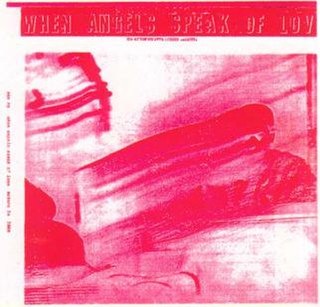
When Angels Speak of Love is a music album by the American Jazz musician Sun Ra and his Myth Science Arkestra. Originally released in 1966 on Sun Ra's own Saturn label, the record would have only been available by mail order or sold at Arkestra concerts, and is one of the rarest of all Saturn releases. The record was reissued on compact disc by Evidence in 2000.

Other Planes of There is an album by the American Jazz musician Sun Ra and his Solar Arkestra. Recorded in 1964, the album had been released by 1966 on Sun Ra's own Saturn label. The record was reissued on compact disc by Evidence in 1992.
'Granted, the selection is certainly not as abrasive and demanding as later efforts, although there is strident involvement from everyone within the dense arrangement. The brass and reed sections provide emphasis behind an off-kilter and loping waltz backdrop. All the more impressive is how well the material has held up over the decades. Even to seasoned ears, the music is pungent and uninhibited, making Other Planes of There a highly recommended collection.' Lindsay Planer

Holiday For Soul Dance is an album by the American jazz musician Sun Ra and his Intergalactic Arkestra recorded in Chicago, mid-1960 and originally released on his own Saturn label in 1970. The album was reissued by Evidence on Compact disc in 1992. Within Ra's catalogue, Holiday For Soul Dance is considered a bit of an oddity as it lacks any tracks written by Sun Ra, although a song written by Phil Cohran, the Arkestra's cornet player, is included. The record is one of a trio of albums recorded between 1959 and 1961, featuring jazz standards, that Ra released in the early 1970s. The others were Sound Sun Pleasure!! and Bad and Beautiful.



















